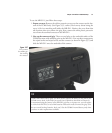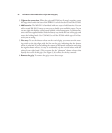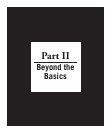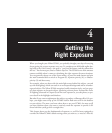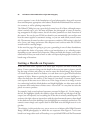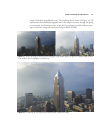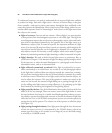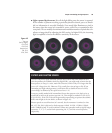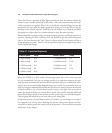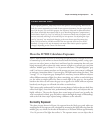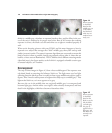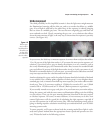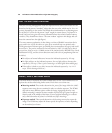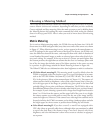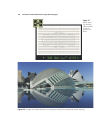
■ Light captured by the sensor. Not all the light falling onto the sensor is captured.
If the number of photons reaching a particular photosite doesn’t pass a set thresh-
old, no information is recorded. Similarly, if too much light illuminates a pixel in
the sensor, then the excess isn’t recorded or, worse, spills over to contaminate adja-
cent pixels. We can modify the minimum and maximum number of pixels that con-
tribute to image detail by adjusting the ISO setting. At higher ISOs, the incoming
light is amplified to boost the effective sensitivity of the sensor.
Chapter 4 ■ Getting the Right Exposure 99
Figure 4.3
Top row
(left to right):
f/2, f/2.8,
f/4, f/5.6;
bottom row,
f/8, f/11,
f/16, f/22.
F/STOPS AND SHUTTER SPEEDS
If you’re really new to more advanced cameras (and I realize that some ambitious ama-
teurs do purchase the D7000 as their first digital SLR), you might need to know that the
lens aperture, or f/stop, is a ratio, much like a fraction, which is why f/2 is larger than f/4,
just as 1/2 is larger than 1/4. However, f/2 is actually four times as large as f/4. (If you
remember your high-school geometry, you’ll know that to double the area of a circle,
you multiply its diameter by the square root of two: 1.4.)
Lenses are usually marked with intermediate f/stops that represent a size that’s twice as
much/half as much as the previous aperture. So, a lens might be marked: f/2, f/2.8, f/4,
f/5.6, f/8, f/11, f/16, f/22, with each larger number representing an aperture that admits
half as much light as the one before, as shown in Figure 4.3.
Shutter speeds are actual fractions (of a second), but the numerator is omitted, so that
60, 125, 250, 500, 1,000, and so forth represent 1/60th, 1/125th, 1/250th, 1/500th,
and 1/1,000th second. To avoid confusion, Nikon uses quotation marks to signify longer
exposures: 2", 2"5, 4", and so forth representing 2.0, 2.5, and 4.0-second exposures,
respectively.



